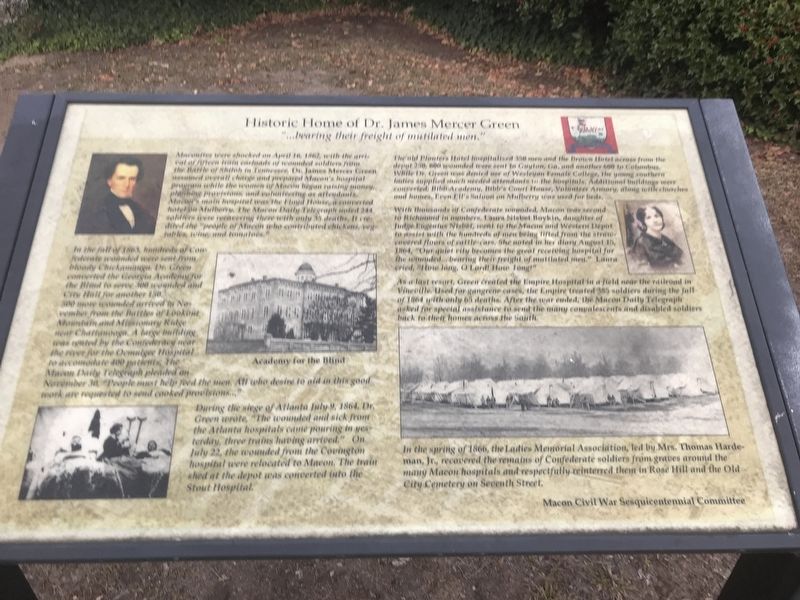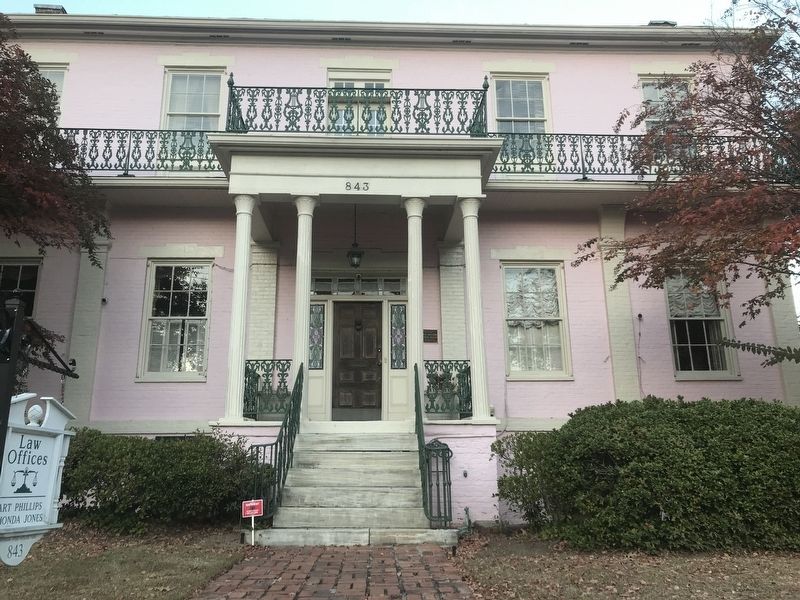Macon in Bibb County, Georgia — The American South (South Atlantic)
Historic Home of Dr. James Mercer Green
"… bearing their freight of mutilated men."
Inscription.
Maconites were shocked on April 16, 1862, with the arrival of fifteen train carloads of wounded soldiers from the Battle of Shiloh in Tennessee. Dr. James Mercer Green assumed overall charge and prepared Macon's hospital program while the women of Macon began raising money, planning provisions and volunteering as attendants. Macon's main hospital was the Floyd House, a converted hotel on Mulberry. The Macon Daily Telegraph noted 244 soldiers were recovering there with only 35 deaths. It credited the “people of Macon who contributed chickens, vegetables, wine and tomatoes.”
In the fall of 1863, hundreds of Confederate wounded were sent from bloody Chickamauga. Dr. Green converted the Georgia Academy for the Blind to serve 300 wounded and City Hall for another 150. 500 more wounded arrived in November from the Battle of Lookout Mountain and Missionary Ridge near Chattanooga. A large building was rented by the Confederates near the river for the Ocmulgee Hospital to accommodate 400 patients. The Macon Daily Telegraph pleaded on November 30, “People must help feed the men. All who desire to aid in this good work are requested to send cooked provisions … ”
During the Siege of Atlanta July 9, 1864, Dr. Green wrote, “The wounded and sick from the Atlanta hospitals came pouring in yesterday, three trains having arrived.” On July 22, the wounded from the Covington hospital were relocated to Macon. The train shed at the depot was converted into the Stout Hospital.
The old Planters Hotel hospitalized 350 men and the Brown Hotel across from the depot 250; 600 wounded were sent to Guyton, Ga., and another 600 to Columbus. While Dr. Green was denied use of Wesleyan Female College, the young southern ladies supplied much needed attendants to the hospitals. Additional buildings were converted: Bibb Academy, Bibb's Court House, Volunteer Armory, along with churches and homes. Even Ell's Saloon on Mulberry was used for beds.
With thousands of Confederate wounded, Macon was second to Richmond in numbers. Laura Nisbet Boykin, daughter of Judge Eugenius Nisbet, went to the Macon and Western Depot to assist with the hundreds of men being lifted from the straw-covered floors of cattle cars. She noted in her diary August 15, 1864, “Our quiet city becomes the great receiving hospital for the wounded … bearing their freight of mutilated men.” Laura cried, “How long, O Lord! How long!”
As a last resort, Green created the Empire Hospital in a field near the railroad in Vineville. Used for gangrene cases, the Empire treated 385 soldiers during the fall of 1864 with only 65 deaths. After the war ended, the Macon Daily Telegraph asked for special assistance to send the many
convalescents and disabled soldiers back to their homes across the South.
In the Spring of 1866, the Ladies Memorial Association, led by Mrs. Thomas Hardemen, Jr., recovered the remains of Confederate soldiers from graves around the many Macon hospitals and respectfully reinterred them in Rose Hill and the Old City Cemetery on Seventh Street.
Erected by Macon Civil War Sesquicentennial Committee.
Topics. This historical marker is listed in these topic lists: Science & Medicine • War, US Civil. A significant historical date for this entry is April 16, 1862.
Location. 32° 50.258′ N, 83° 38.017′ W. Marker is in Macon, Georgia, in Bibb County. Marker is at the intersection of Poplar Street (Business U.S. 41) and High Place, on the right when traveling north on Poplar Street. Touch for map. Marker is at or near this postal address: 843 Poplar St, Macon GA 31201, United States of America. Touch for directions.
Other nearby markers. At least 8 other markers are within walking distance of this marker. Green-Poe House (here, next to this marker); The First Baptist Church of Christ (within shouting distance of this marker); St. Joseph's Catholic Church (within shouting distance of this marker); Capricorn Park (about 600 feet away, measured in a direct line); Temple Beth Israel (about 600 feet away); Walton Building (about
600 feet away); City Hall & Old Capitol (about 600 feet away); Macon City Hall (about 700 feet away). Touch for a list and map of all markers in Macon.
Credits. This page was last revised on November 13, 2023. It was originally submitted on November 26, 2021, by Duane and Tracy Marsteller of Murfreesboro, Tennessee. This page has been viewed 348 times since then and 53 times this year. Photos: 1. submitted on November 26, 2021, by Duane and Tracy Marsteller of Murfreesboro, Tennessee. 2. submitted on November 13, 2023, by J. Makali Bruton of Accra, Ghana. 3. submitted on November 26, 2021, by Duane and Tracy Marsteller of Murfreesboro, Tennessee.


